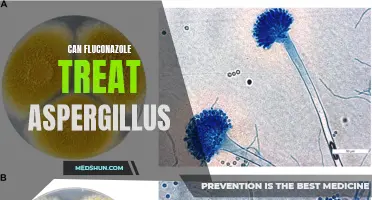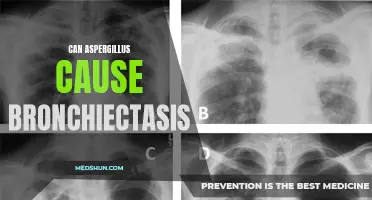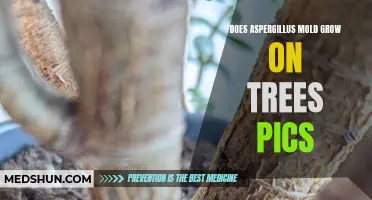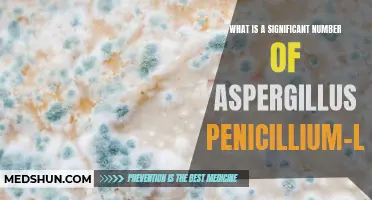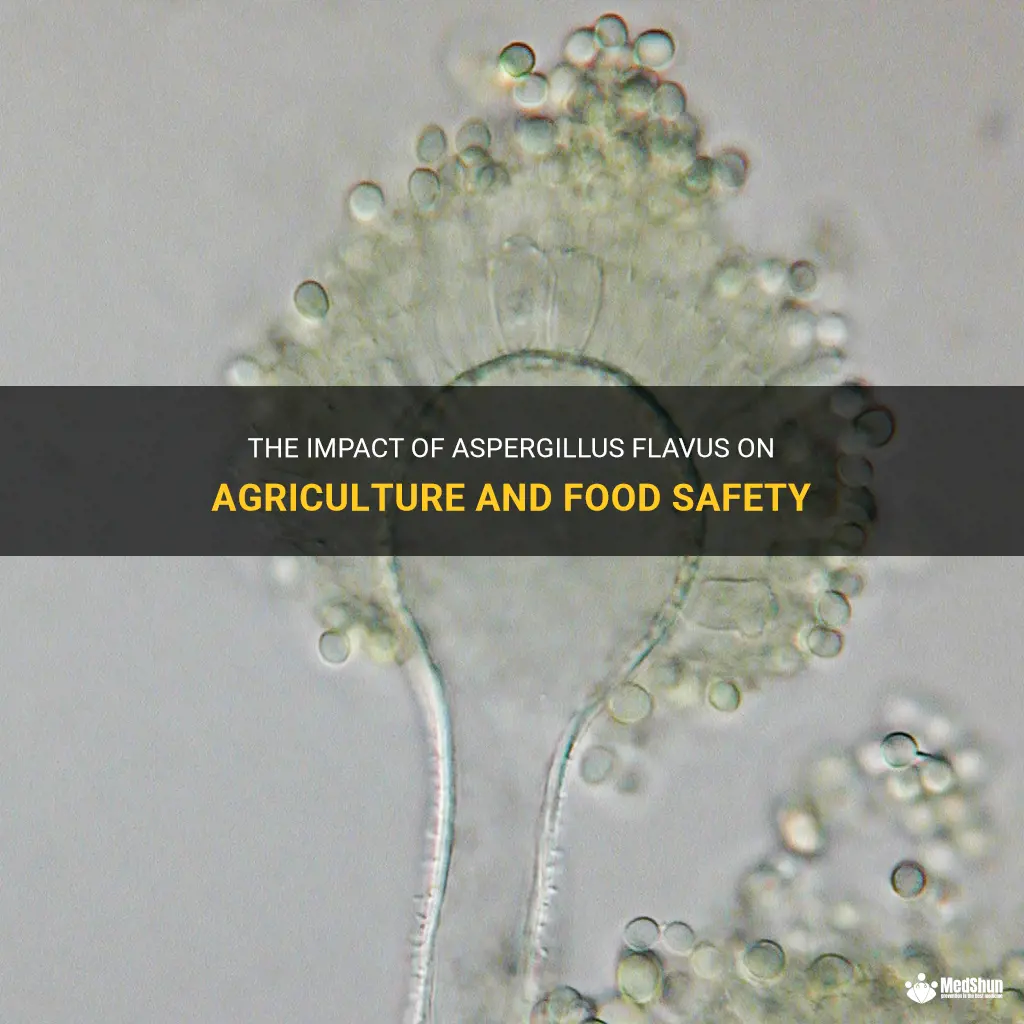
Aspergillus flavus is a fascinating and perplexing fungus that has captured the attention of scientists and researchers for years. With its distinctive yellow-green color and unique ability to produce toxic compounds called aflatoxins, this fungus holds a menacing presence in many industries, from agriculture to food production. Aspergillus flavus not only poses a threat to crops, but also to human and animal health, making it a crucial subject of study in the field of microbiology. In this article, we will dive into the world of Aspergillus flavus, exploring its characteristics, impact, and potential solutions to prevent its harmful effects.
| Characteristics | Values |
|---|---|
| Kingdom | Fungi |
| Phylum | Ascomycota |
| Class | Eurotiomycetes |
| Order | Eurotiales |
| Family | Aspergillaceae |
| Genus | Aspergillus |
| Species | flavus |
| Morphology | Conidia are hyaline to yellow-green, measuring 3-5 µm in diameter with a rough surface and a distinct small scar |
| Growth Temperature | 20-42°C |
| Optimum Temperature | 37°C |
| Growth Rate | Moderate to fast |
| Habitat | Soil, decaying plant material, air |
| Pathogenicity | Can cause infection in humans and animals; produces aflatoxins |
| Aflatoxin production | Aflatoxin B1, B2, G1, G2, M1, and M2 |
| Toxigenicity | Highly toxigenic |
| Mode of Transmission | Inhalation, ingestion |
| Clinical Manifestations | Allergic bronchopulmonary aspergillosis, aspergilloma, invasive aspergillosis |
| Treatment | Antifungal medications (e.g. voriconazole, itraconazole) |
| Prevention | Avoidance of exposure to spores, proper storage of food to prevent aflatoxin contamination |
What You'll Learn
- What is Aspergillus flavus and what role does it play in the environment?
- How does Aspergillus flavus produce toxins, and what are the potential health risks associated with exposure to these toxins?
- What are the ideal conditions for Aspergillus flavus growth, and how can these conditions be controlled to prevent its proliferation?
- Are there any specific industries or agricultural practices that are particularly susceptible to Aspergillus flavus contamination, and what measures can be taken to reduce the risk?
- What are some effective methods for diagnosing and treating infections or illnesses caused by Aspergillus flavus?

What is Aspergillus flavus and what role does it play in the environment?
Aspergillus flavus is a fungus that is commonly found in the environment and is known to have both beneficial and harmful effects. It is a filamentous fungus that belongs to the genus Aspergillus, which is widely distributed in soil and various organic substrates.
One of the notable characteristics of A. flavus is its ability to produce a group of toxic compounds known as aflatoxins. Aflatoxins are highly carcinogenic and pose a significant risk to human and animal health when consumed in contaminated food or feed. A. flavus can contaminate a wide range of crops, including peanuts, corn, cottonseed, and tree nuts, leading to significant economic losses in the agricultural industry.
However, A. flavus also plays a vital role in the environment. It is considered a saprophyte, meaning it feeds on dead organic matter, such as fallen leaves, decaying wood, and plant debris. By breaking down these materials, A. flavus contributes to the nutrient recycling process and helps maintain the overall health and balance of ecosystems.
In addition to its role as a decomposer, A. flavus also forms a symbiotic relationship with certain plants. For example, it can colonize the rhizosphere of some crop plants, such as corn and peanuts, forming a beneficial association. In this association, A. flavus helps the plants acquire essential nutrients, such as phosphorus, by solubilizing complex compounds in the soil and making them available for plant uptake. This interaction between A. flavus and plants is particularly crucial in nutrient-poor soils.
Despite its beneficial role in nutrient cycling and plant symbiosis, A. flavus can become a threat when conditions are favorable for aflatoxin production. Factors such as high temperature, humidity, drought stress, and poor agricultural practices can significantly increase aflatoxin contamination in crops. Therefore, it is crucial to monitor and manage A. flavus populations to minimize the risk posed by aflatoxins.
Several strategies have been developed to control A. flavus and reduce aflatoxin contamination in crops. These include the use of biocontrol agents, such as certain strains of non-aflatoxigenic A. flavus, which can outcompete the toxigenic strains and suppress their growth and aflatoxin production. Additionally, good agricultural practices, such as proper crop rotation, irrigation management, and timely harvest, can help reduce the risk of A. flavus contamination.
In conclusion, Aspergillus flavus is a fungus that can have both beneficial and harmful effects. While it plays a vital role in the environment as a decomposer and a symbiont of certain plants, it can also produce the highly toxic aflatoxins, posing a significant risk to human and animal health. Understanding its ecology and developing effective control strategies are essential to mitigate the risks associated with A. flavus contamination.
Exploring the Growth Potential of Aspergillus in Liquid Environments
You may want to see also

How does Aspergillus flavus produce toxins, and what are the potential health risks associated with exposure to these toxins?
Aspergillus flavus is a common mold that is responsible for the production of a harmful toxin known as aflatoxin. This mold can grow on a variety of food and feed crops, including corn, peanuts, cottonseed, and tree nuts. The toxin produced by Aspergillus flavus is a potent carcinogen and can pose serious health risks to humans and animals.
The process by which Aspergillus flavus produces aflatoxin begins with the introduction of fungal spores to a suitable substrate, such as a corn kernel. Once on the substrate, the spores germinate and grow into a network of branching hyphae. These hyphae then produce enzymes that break down complex organic compounds in the substrate, providing the mold with the nutrients it needs to survive.
As the mold continues to grow, it produces asexual spores known as conidia. These conidia are dispersed into the environment, allowing the mold to colonize new substrates. Under certain environmental conditions, such as high temperatures and humidity, the mold will begin to produce aflatoxin.
Aflatoxin is produced through a complex biosynthetic pathway involving several enzymes. One of the most important enzymes in this pathway is called aflatoxin biosynthesis gene cluster. This cluster contains several genes that encode enzymes responsible for the production of aflatoxin.
The production of aflatoxin by Aspergillus flavus is highly regulated and influenced by a variety of environmental factors. Temperature, humidity, and substrate composition all play important roles in determining the level of aflatoxin produced by the mold. Additionally, certain strains of Aspergillus flavus may produce more aflatoxin than others, further contributing to the variability in toxin levels.
Exposure to aflatoxin can have serious health consequences. In humans, aflatoxin is a potent carcinogen and has been linked to the development of liver cancer. Long-term exposure to low levels of aflatoxin can also impair immune function and contribute to the development of chronic liver disease.
Livestock and poultry are also at risk of exposure to aflatoxin. Animals that consume contaminated feed can suffer from a variety of health problems, including liver damage, reduced growth rates, and reproductive issues. In severe cases, consumption of high levels of aflatoxin can lead to death.
To mitigate the health risks associated with Aspergillus flavus and aflatoxin contamination, it is important to implement proper storage and processing techniques for crops and feed. This includes maintaining suitable moisture levels, controlling temperature, and implementing appropriate storage and handling practices. Regular monitoring and testing for aflatoxin contamination can also help identify and prevent exposure to this harmful toxin.
Overall, Aspergillus flavus and its toxin aflatoxin pose significant health risks to humans and animals. Understanding the biology and production of these toxins is crucial in developing strategies to mitigate their impact and protect public health.
Understanding the Formation of Aspergillus fumigatus 96918 Biofilm
You may want to see also

What are the ideal conditions for Aspergillus flavus growth, and how can these conditions be controlled to prevent its proliferation?
Aspergillus flavus is a fungus that is commonly found in various environmental conditions. It is known for producing a harmful toxin called aflatoxin, which can contaminate crops and pose a serious threat to human and animal health. Understanding the ideal conditions for Aspergillus flavus growth and implementing control measures is crucial in preventing its proliferation.
- Temperature: Aspergillus flavus thrives in warm temperatures, with an optimal range of 25-30 degrees Celsius. At these temperatures, the fungus can grow and reproduce rapidly. To control its growth, it is important to maintain temperature control in storage facilities, especially for crops prone to aflatoxin contamination such as peanuts and corn.
- Moisture: Adequate moisture is another key factor for Aspergillus flavus growth. High humidity or moisture content in stored crops can create a favorable environment for fungal growth. It is crucial to keep moisture levels below specific thresholds to prevent fungal proliferation. For example, in corn, it is recommended to maintain moisture levels below 15% to minimize the risk of Aspergillus flavus contamination.
- Oxygen: Aspergillus flavus is an aerobic organism, meaning it requires oxygen to grow and survive. Adequate oxygen supply is therefore necessary for its proliferation. Proper ventilation in storage facilities is essential to maintain oxygen levels and prevent the buildup of carbon dioxide, which can inhibit fungal growth.
- Substrate availability: Aspergillus flavus can grow on a variety of substrates, including crops, animal feed, and decaying organic matter. Controlling substrate availability is crucial in preventing its proliferation. Regular cleaning and maintenance of storage facilities can help eliminate potential food sources for the fungus, reducing the risk of contamination.
- Prevention measures: Implementing control measures to prevent Aspergillus flavus growth is essential in minimizing aflatoxin contamination. Some effective prevention strategies include:
- Proper drying: Thoroughly drying crops after harvest is crucial to reduce moisture content and inhibit fungal growth. Special attention should be given to drying susceptible crops such as peanuts and corn.
- Storage conditions: Proper storage conditions, including temperature and humidity control, are critical in preventing fungal growth. Regular monitoring of storage facilities is necessary to detect any changes in conditions that could promote Aspergillus flavus proliferation.
- Use of biocontrol agents: Some biocontrol agents, such as the non-toxigenic strain of Aspergillus, have been found to compete with Aspergillus flavus and reduce aflatoxin contamination. The application of these agents can help prevent fungal proliferation and reduce the risk of toxin production.
- Screening and sorting: Implementing strict screening and sorting procedures for crops can help identify and eliminate contaminated samples, reducing the risk of aflatoxin exposure.
In conclusion, understanding the ideal conditions for Aspergillus flavus growth and implementing control measures is crucial in preventing its proliferation and minimizing aflatoxin contamination. By maintaining appropriate temperature, moisture, oxygen levels, and controlling substrate availability, the risk of fungal growth can be significantly reduced. Additionally, implementing prevention measures such as proper drying, storage conditions, use of biocontrol agents, and screening and sorting procedures can further aid in preventing fungal proliferation and minimizing the threat of aflatoxin contamination in crops.
Is Aspergillus the Cause of Toenail Fungus?
You may want to see also

Are there any specific industries or agricultural practices that are particularly susceptible to Aspergillus flavus contamination, and what measures can be taken to reduce the risk?
Aspergillus flavus is a fungus commonly found in agricultural and industrial environments. This fungus produces a secondary metabolite called aflatoxin, which is highly toxic to humans and animals when ingested. Aflatoxin contamination poses a significant risk to food safety, and it is crucial to understand which industries and agricultural practices are more susceptible to Aspergillus flavus contamination and what measures can be taken to reduce the risk.
One industry that is particularly susceptible to Aspergillus flavus contamination is the grain and feed industry. Corn, peanuts, cottonseed, and tree nuts are some of the main crops at risk. These crops are often stored under conditions that promote fungal growth, such as warm and humid environments. Additionally, improper drying and storage practices can further enhance the risk of Aspergillus flavus contamination.
Agricultural practices that create conditions favorable for Aspergillus flavus contamination include poor harvesting techniques, improper drying, and inadequate storage facilities. For example, when crops are harvested too early or during wet periods, they are more likely to retain higher levels of moisture, promoting fungal growth. Similarly, if crops are not dried promptly and thoroughly, moisture content can reach levels ideal for Aspergillus flavus to thrive.
To reduce the risk of Aspergillus flavus contamination, several measures can be taken.
- Crop rotation: Implementing crop rotation practices can help break the disease cycle and reduce the build-up of fungal spores in the soil. Changing crops periodically reduces the availability of food sources for Aspergillus flavus and other pathogens.
- Proper harvesting techniques: It is essential to harvest crops at the optimum maturity stage and under dry weather conditions. This minimizes moisture levels and reduces the chances of fungal contamination.
- Adequate drying: Ensuring that crops are dried promptly and thoroughly is crucial. Proper drying techniques, such as the use of forced-air drying systems or drying under the sun, can help reduce moisture content and inhibit fungal growth. Monitoring the moisture content of crops during the drying process is also essential.
- Storage conditions: Providing suitable storage conditions is critical to minimize the risk of Aspergillus flavus contamination. Storage facilities should be clean, dry, and well-ventilated. Regular inspection and maintenance of storage structures are necessary to prevent moisture build-up and the presence of pests, which can create entry points for fungal contamination.
- Aflatoxin testing: Regular testing of crops and processed products for aflatoxin levels is essential to ensure food safety. This helps identify contaminated batches and prevent the distribution of aflatoxin-contaminated products.
- Biological control: Some studies have shown the potential of certain strains of non-toxic Aspergillus flavus strains as biocontrol agents. These biocontrol strains can effectively compete with the toxic strains, reducing the aflatoxin contamination risk. However, further research and field trials are needed before widespread implementation.
It is worth noting that while these measures can help reduce the risk of Aspergillus flavus contamination, complete elimination of the fungus is challenging. Therefore, it is crucial to prioritize prevention strategies and implement good agricultural and storage practices to minimize the incidence of aflatoxin contamination and ensure food safety.
Does Every Cereal Contain Aspergillus?
You may want to see also

What are some effective methods for diagnosing and treating infections or illnesses caused by Aspergillus flavus?
Aspergillus flavus is a species of fungus that can cause serious infections or illnesses in both humans and animals. This fungus is commonly found in soil and decaying plant material, and it produces a variety of toxins, including aflatoxin, which can be highly carcinogenic. Infections caused by Aspergillus flavus can be challenging to diagnose and treat, but there are several effective methods that can be used.
Diagnosing an infection or illness caused by Aspergillus flavus typically begins with a thorough examination of the patient's symptoms and medical history. Common symptoms of an Aspergillus flavus infection can include fever, cough, chest pain, difficulty breathing, and skin lesions. It is also important to consider any potential risk factors, such as recent exposure to contaminated soil or plants.
Once a suspicion of an Aspergillus flavus infection has been raised, there are several laboratory tests that can be conducted to confirm the diagnosis. One of the most commonly used tests is a fungal culture, where a sample of tissue or fluid is taken from the infected area and placed in a culture medium that promotes the growth of Aspergillus flavus. If the fungus grows in the culture, it can be identified using various methods, such as microscopy and genetic sequencing.
Another important diagnostic tool for Aspergillus flavus infections is imaging studies, such as chest X-rays or CT scans. These tests can help identify characteristic patterns of infection, such as the presence of nodules or cavities in the lungs. Additionally, blood tests may be performed to measure the levels of certain antibodies or immune cells that are associated with Aspergillus flavus infections.
Once a diagnosis has been confirmed, the next step is to determine the appropriate treatment for the infection. The choice of treatment will depend on several factors, including the severity and location of the infection, as well as the overall health of the patient. In some cases, antifungal medications may be prescribed to help kill the fungus and prevent it from spreading. Commonly used antifungal drugs for Aspergillus flavus infections include voriconazole, itraconazole, and amphotericin B.
Surgery may also be necessary in certain cases, especially if the infection has spread to vital organs or if there is a buildup of fluid or pus that needs to be drained. For example, if an Aspergillus flavus infection has developed in the sinuses, a surgical procedure called endoscopic sinus surgery may be performed to remove the infected tissue and improve drainage.
In addition to medical treatments, it is also important to address any underlying risk factors that may have contributed to the infection. For example, if the infection was caused by exposure to contaminated soil or plants, steps should be taken to prevent further exposure, such as wearing protective clothing or improving sanitation measures.
In conclusion, diagnosing and treating infections or illnesses caused by Aspergillus flavus can be challenging but is crucial to prevent serious complications. A combination of thorough clinical evaluation, laboratory tests, and imaging studies can help confirm the diagnosis. Treatment may involve antifungal medications, surgery, and addressing underlying risk factors. Prompt and appropriate management can improve outcomes and reduce the risk of complications in patients affected by Aspergillus flavus infections.
Can Aspergillus Oryzae Cause a Skin Infection: Exploring the Link
You may want to see also
Frequently asked questions
Aspergillus flavus is a type of fungus that is commonly found in soil and decaying plant material. It can produce toxic compounds called aflatoxins, which have been linked to various health problems in humans and animals. This fungus is particularly known for contaminating crops such as corn, peanuts, and tree nuts.
Aspergillus flavus spreads through the release of spores into the air. These spores can be carried by wind or water to other areas and can easily contaminate crops or stored food products. The fungus thrives in warm and humid environments, making it more common in tropical and subtropical regions. It can also survive in dry conditions, such as in stored grains or nuts, and can remain dormant until the conditions are favorable for growth.
The main health risk associated with Aspergillus flavus is the exposure to aflatoxins. These toxins are potent carcinogens and can cause liver damage, liver cancer, and other diseases in humans and animals. Consuming aflatoxin-contaminated food products can lead to acute or chronic aflatoxicosis, which can be fatal in severe cases. Therefore, it is important to minimize exposure to Aspergillus flavus and prevent the contamination of food and feed supplies.


